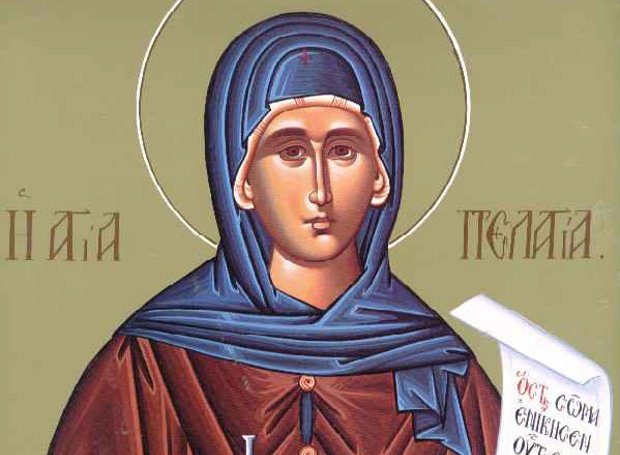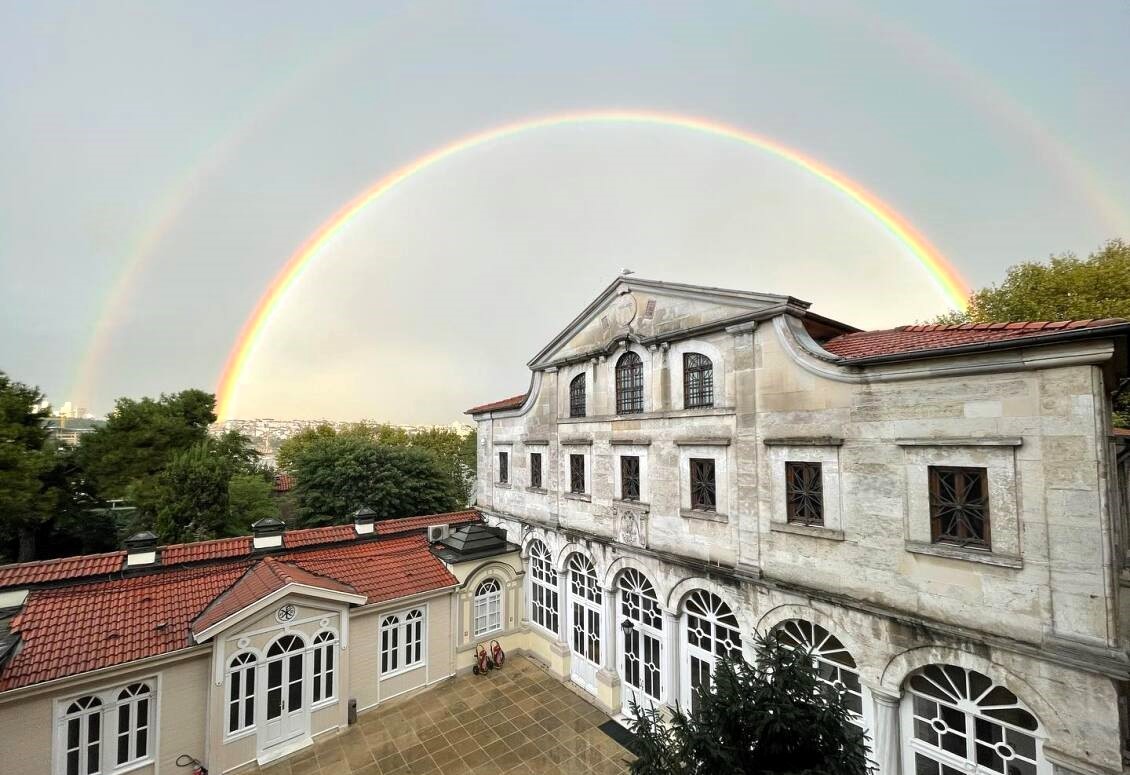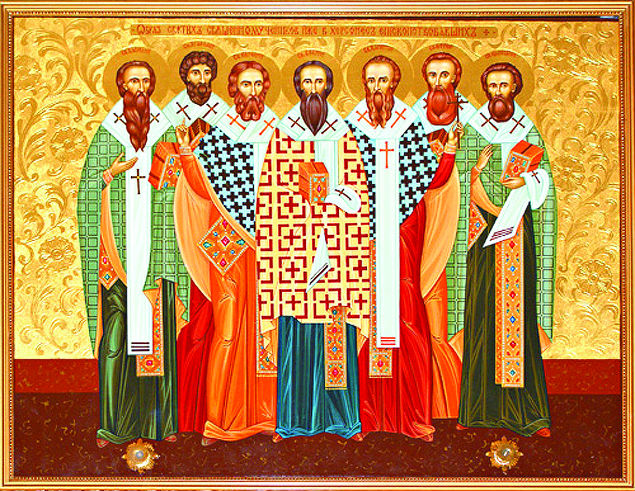Venerable Pelagia the Penitent (8 October)

Saint Pelagia the Penitent was converted to Christianity by Saint Nonnus, Bishop of Edessa (Saturday of Cheesefare Week). Before her acceptance of Christianity through Baptism, Pelagia was head of a dance troupe in Palestinian Antioch, living a life of frivolity and prostitution.
One day Pelagia, elegantly dressed, was making her way past a church where Saint Nonnus was preaching a sermon. Believers turned their faces away from the sinner, but the bishop glanced after her. Struck by the outer beauty of Pelagia and having foreseen the spiritual greatness within her, the saint prayed in his cell for a long time to the Lord for the sinner. He told his fellow bishops that the prostitute put them all to shame. He explained that she took great care to adorn her body in order to appear beautiful in the eyes of men. “We… take no thought for the adornment of our wretched souls,” he said.
On the following day, when Saint Nonnus was teaching in the church about the dread Last Judgment and its consequences, Pelagia came. The teaching made a tremendous impression upon her. With the fear of God and weeping tears of repentance, she asked the saint for Baptism. Seeing her sincere and full repentance, Bishop Nonnus baptized her.
By night the devil appeared to Pelagia, urging her to return to her former life. The saint prayed, signed herself with the Sign of the Cross, and the devil vanished.
Three days after her baptism, Saint Pelagia gathered up her valuables and took them to Bishop Nonnus. The bishop ordered that they be distributed among the poor saying, “Let this be wisely dispersed, so that these riches gained by sin may become a wealth of righteousness.” After this Saint Pelagia journeyed to Jerusalem to the Mount of Olives. She lived there in a cell, disguised as the monk Pelagius, living in ascetic seclusion, and attaining great spiritual gifts. When she died, she was buried in her cell.
![]()
Pelagia was a repentant sinner. She was born to pagan parents in Antioch, and was endowed by God with great physical beauty. Pelagia used her beauty to the destruction of her own soul and those of others. She became very wealthy as a result of her prostitution. Once, while walking past the Church of the Holy Martyr Julian, in which Bishop Nonnus was preaching, she stopped in and heard a sermon on the Dread Judgment and the punishment of sinners. Those words so shook her and changed her that she immediately felt revulsion for herself, acquired true fear of God, repented of all her sins and fell down before St. Nonnus with the plea that he baptize her: “Have mercy on me, a sinner, holy Father. Baptize me and teach me repentance–I am a sea of iniquity, an abyss of destruction, a net and weapon of the devil.”
Thus this penitent begged the hierarch of Christ with tears, and he baptized her. At her baptism, Blessed Romana, the deaconess of the church, was her godmother. Romana, as her spiritual mother, grounded her well in the Christian Faith. But Pelagia was not satisfied with baptism alone. She was keenly aware of the multitude of her sins and, pricked by her conscience, decided on a great ascetic labor. She left her enormous, sinfully gained wealth to the poor, and secretly went to Jerusalem as the monk Pelagius. There, she shut herself up in a cell on the Mount of Olives, and began the difficult ascesis of fasting, prayer and all-night vigils. After three years, St. Nonnus’s deacon, James, visited her and found her still alive, but when he visited her again several days later, he found that she had reposed, and he honorably buried her body. St. Pelagia entered into rest in about the year 461 A.D. Thus, this formerly terrible sinner pleased God by her repentance and labor, was forgiven of her sins, and became sanctified. And her purified and enlightened soul was deemed worthy of the Kingdom of God.
This Saint was a prominent actress of the city of Antioch, and a pagan, who lived a life of unrestrained prodigality and led many to perdition. Instructed and baptized by a certain bishop named Nonnus (Saint Nonnus is commemorated Nov. 10), she departed for the Mount of Olives near Jerusalem, where she lived as a recluse, feigning to be a eunuch called Pelagia. She lived in such holiness and repentance that within three or four years she was deemed worthy to repose in an odour of sanctity, in the middle of the fifth century. Her tomb on the Mount of Olives has been a place of pilgrimage ever since.
Apolytikion of Righteous Pelagia
Plagal of the Fourth Tone
The image of God, was faithfully preserved in you, O Mother. For you took up the Cross and followed Christ. By Your actions you taught us to look beyond the flesh for it passes, rather to be concerned about the soul which is immortal. Wherefore, O Holy Pelagia, your soul rejoices with the angels.
Kontakion of Righteous Pelagia
Second Tone
With fasting didst thou consume thy body utterly; with vigilant prayer didst thou entreat thy Fashioner that complete forgiveness of thy former deeds be granted thee, which, O Mother, thou didst receive. The path of repentance hast thou shown to us.
Source: oca.org / goarch.org / westserbdio.com





